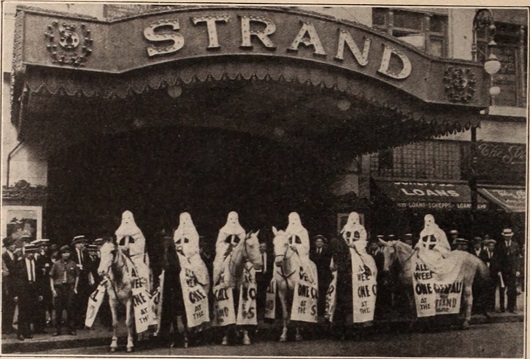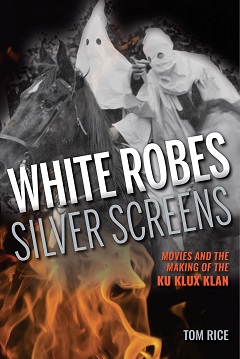The KKK – 100 years on

New research by a film expert at the University of St Andrews suggests that the Ku Klux Klan were forerunners in the use of modern media, adept at creating the kind of buzz today associated with social media – as far back as one hundred years ago.
Writing in a book released to coincide with the 100 year anniversary of the rebirth of the KKK, Dr Tom Rice examines how the Klan infiltrated mainstream America with its ‘surprising and innovative use’ of film and media.
The book, White Robes, Silver Screens: Movies and the Making of the Ku Klux Klan, uncovers archival material dating from the launch of the second formation of the KKK in 1915. The new study shows how, as well as producing their own films and running their own cinemas, the Klan featured in major Hollywood productions starring the biggest names of the period, including Doris Day, Mary Pickford and Humphrey Bogart.
The book is published this week almost 100 years to the day (6 December 1915) that the newly formed Klan reportedly paraded outside the Atlanta Premiere of ‘The Birth of a Nation’; one of the most controversial movies of all time, the film featured ‘heroic’ Klansmen and was used by the group to help with its relaunch and growth.
Author Dr Tom Rice is Director of Teaching and a lecturer in Film Studies at the University of St Andrews.
He said: “Within a decade of forming in Atlanta in 1915, the Ku Klux Klan had established itself as one of the most influential and recognisable social and political forces in America. To understand how it recruited millions of members and manoeuvred itself within mainstream America, we need to look more closely at its surprising and innovative use of film and media.
“Today, we still associate the Klan with a particular set of images, whether it’s the fiery cross, the white robes, or the riding horseman. Much of this imagery, from which the Klan’s power and notoriety stems, derives from film, created, popularised and, later, challenged on screen.”
Dr Rice explores the little-known relationship between the Klan’s success and its use of film and media in the interwar years when the image, function and moral rectitude of the Klan was contested on the national stage.
“The Klan featured in unusual contexts. Klan-like characters appeared in Disney cartoons while the Klan’s initials were used to promote silent movie comic Buster Keaton’s latest film, although after much publicity it was revealed that the slogan ‘KKK is coming!’ actually stood for ‘Keaton’sKolossal Komedy’. Even Superman fought the Klan in a 1946 radio series.”
 In its second incarnation, the KKK emerged as one of the most powerful social and political organisations in America. With an estimated 5 million members by the mid-1920s, it oversaw a massive publicity operation with its own ‘propagation department’.
In its second incarnation, the KKK emerged as one of the most powerful social and political organisations in America. With an estimated 5 million members by the mid-1920s, it oversaw a massive publicity operation with its own ‘propagation department’.
By examining rich archival materials – including a series of films produced by the Klan and a wealth of documents, newspaper clippings and manuals – Dr Rice uncovered the fraught history of the Klan as a local force that manipulated the American film industry to extend its reach across the country.
The new work also examines how, at its height in the 1920s, the Klan protested against a number of films and stars including Charlie Chaplin. It managed to remove Chaplin’s The Pilgrim from many screens but, despite taking legal action, failed to recoup ‘royalties’ for the appearance of the ‘Klan insignia’ in the Humphrey Bogart film, Black Legion. Its offer to endorse “Gone With the Wind” was also dismissed by makers of the 1939 classic.
Dr Rice continued: “Here was a reactionary, conservative organisation that was publishing newspapers and producing films and radio shows, that owned theatres and staged large-scale community plays. It had its own bands and baseball teams, a University, a successful women’s group and a strong presence in local Protestant churches. The Klan used film – whether producing, or protesting against Hollywood – to recruit members, shape public behaviour and define its role within American society. They were at the cutting-edge of what we understand today as PR. Had social media existed at the time, they would certainly have utilised it to its full effect.”
White Robes, Silver Screens: Movies and the Making of the Ku Klux Klan, by Dr Tom Rice, is published by Indiana University Press. For more information visit the publisher’s website.
Notes to news editors:
Dr Tom Rise is available for interview on 01334 467472 or by email: [email protected]
Note to picture editors:
Caption 1 (previous page): Klan groups produced their own feature films during the 1920s, even publishing an extensive advertising campaign booklet for its 1923 film, The Toll of Justice, of which this is the cover image
Caption 2 (top of this page): Klansmen or actors in Klan robes were used to promote mainstream films, such as One Clear Call when it played on Broadway in 1922
Caption 3: White Robes, Silver Screens book jacket
Issued by the Press Office. Contact 01334 462530 or email [email protected]
Ref: KKK 071215
Category Research